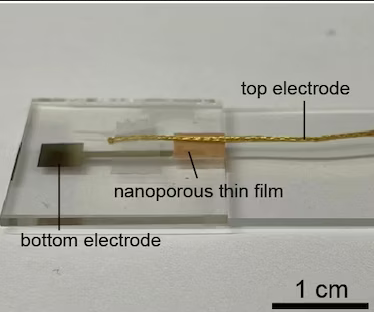
A groundbreaking discovery has been made by scientists from the University of Massachusetts Amherst, who have created a method to extract electricity from the air. Their study reveals that any material can generate a consistent flow of electricity from the moisture present in the atmosphere.
The only components needed are a set of electrodes and a specially designed material consisting of minuscule pores that are smaller than 100 nanometers, which is equivalent to a mere fraction of a human hair’s width.
Allow me to explain the elegant and persuasive workings of this innovative technology: The itty-bitty holes allow water molecules to pass through and generate electricity from the buildup of charge carried by the water molecules.
The process emulates the natural phenomenon of how clouds generate electricity, which is subsequently discharged in the form of lightning bolts, thus lending an air of elegance and persuasiveness to the overall process.

The perpetual presence of humidity in the air renders this electricity harvester a dependable source of power, operating seamlessly round the clock in all weather conditions; unlike other renewable energy technologies such as wind and solar, which can be somewhat erratic.
This new research unveils a remarkable energy-harvesting invention, coined as “Air-gen”, due to its capability of extracting electricity from air. The study findings demonstrate that this device can be constructed using a diverse array of inorganic, organic, and biological substances.

The utilization of the Air-gen device necessitates solely a set of electrodes and a specially designed substance imbued with minute pores. The simplicity of its configuration belies the remarkable benefits it can render.
Water molecules have the ability to travel up to 100 nanometers in the air without colliding with one another. However, when water is transported through a delicate material that contains holes with exact dimensions, an electrical charge accumulates in the upper region of the material where the water molecules enter.
The reduced number of molecules in the lower layer results in a charge discrepancy akin to that found in clouds. This unique occurrence serves as an elegant source of power, fueled by humidity. It is worth noting that the benefits of this phenomenon extend beyond simply causing hair to frizz.
By strategically positioning electrodes on either side of the material, a seamless and efficient transfer of electricity is facilitated, effectively powering any necessary devices or systems.

Despite numerous advancements, scientists are still faced with the challenge of efficiently gathering electricity across a wider expanse, while simultaneously optimizing the vertical layering of sheets to enhance the device’s output without occupying additional physical space.
Reference- Journal Advanced Materials, Interesting Engineering, Popular Science, University of Massachusetts Amherst, Journal Nature, Inverse,






